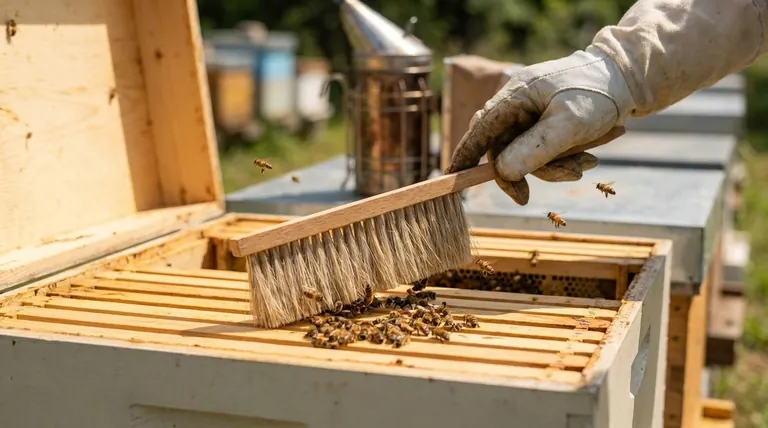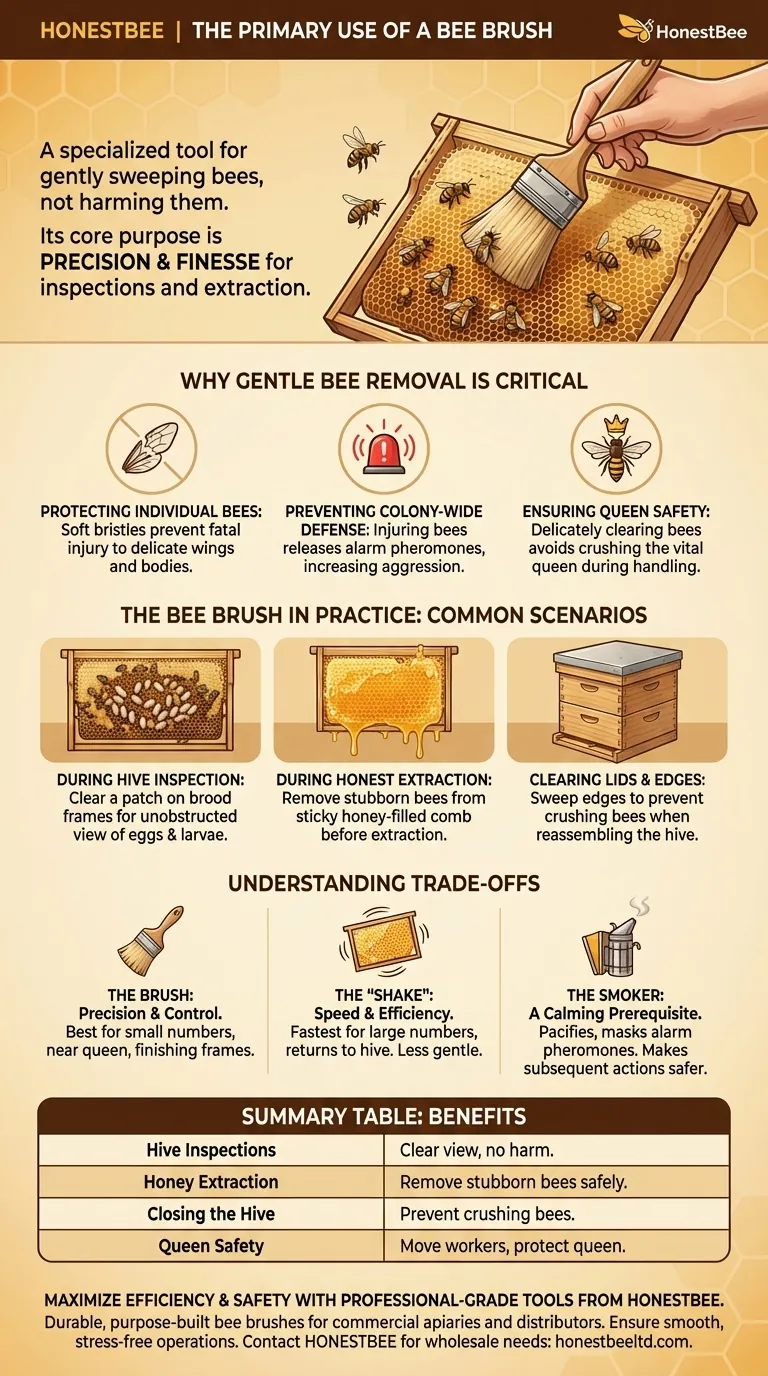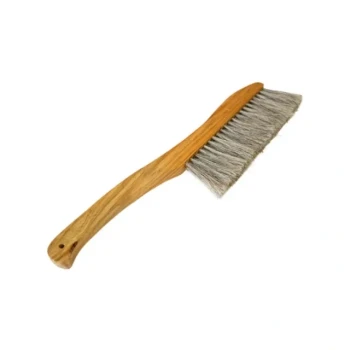A bee brush is a specialized tool used to gently sweep bees off surfaces without causing them harm or agitation. Its primary function during both hive inspections and honey extraction is to carefully move bees from frames, equipment, or the hive body, allowing the beekeeper to see clearly and work safely. The soft, long bristles are designed specifically to avoid injuring the bees' delicate wings and bodies.
The core purpose of a bee brush is not just to move bees, but to do so with precision and gentleness. It is a tool of finesse, essential for situations where more aggressive methods like shaking are inappropriate or ineffective.

Why Gentle Bee Removal is Critical
Understanding why a dedicated brush is necessary is key to effective beekeeping. Aggressive handling can harm individual bees and trigger a defensive response from the entire colony.
Protecting Individual Bees
A bee's body, particularly its wings and legs, is fragile. The soft bristles of a bee brush are designed to nudge bees aside without crushing them or tearing their wings, which would be fatal.
Preventing a Colony-Wide Defense
Injuring or squashing a bee can release alarm pheromones. This chemical signal instantly alerts other bees to a threat, dramatically increasing the chance of stings and making the entire colony agitated and difficult to manage.
Ensuring Queen Safety
The queen bee is the single most important member of the colony. During an inspection, you must always be careful not to harm her. A bee brush allows you to delicately clear worker bees away to get a better view or to handle a frame without risk of accidentally rolling or crushing the queen.
The Bee Brush in Practice: Common Scenarios
The brush is a versatile tool used in several common beekeeping tasks. While a smoker calms the bees, the brush is used for physical relocation.
During a Standard Hive Inspection
When inspecting brood frames, you may need to check the pattern of eggs and larvae. A gentle sweep with the brush can clear a patch of bees, giving you an unobstructed view of the comb cells beneath.
During Honey Extraction
Before you can extract honey, the frames must be completely free of bees. While a firm shake can dislodge the majority of the colony, a brush is essential for removing the stubborn bees that cling to the sticky honey-filled comb.
Clearing Lids and Box Edges
When reassembling a hive, it is crucial to avoid crushing bees between the heavy hive bodies or under the inner cover. A quick sweep with the brush along the edges of the boxes ensures no bees are in harm's way when you place the next box on top.
Understanding the Trade-offs: Brush vs. Other Methods
The bee brush is one of several tools and techniques for moving bees. Knowing when to use each is the mark of an experienced beekeeper.
The Brush: Precision and Control
The brush offers the most precision. It is the best choice when you only need to move a small number of bees, when you are working near the queen, or when clearing the last few stragglers from a honey frame.
The "Shake": Speed and Efficiency
A sharp, downward shake of a frame is the fastest way to dislodge a large number of bees, returning them directly into the hive body below. However, this method is less gentle and should be avoided if a frame is new and fragile or if you have not located the queen.
The Smoker: A Calming Prerequisite
A bee smoker does not move bees; it pacifies them. Puffs of cool smoke mask the alarm pheromones, making the colony less likely to become defensive. Using a smoker is the critical first step that makes subsequent actions, like brushing or shaking, much calmer and safer.
Making the Right Choice for Your Goal
Selecting the correct technique depends entirely on your immediate objective.
- If your primary focus is inspecting a brood frame: Use a brush for delicate work after a puff of smoke, especially if you see the queen.
- If your primary focus is harvesting a full super of honey: Use a firm shake over the hive to dislodge most bees, then use your brush to sweep off the remaining few.
- If your primary focus is closing the hive: Use a brush to gently clear all box rims and the inner cover to avoid crushing any bees.
Mastering your tools is fundamental to becoming a calm, confident, and effective beekeeper.
Summary Table:
| Bee Brush Use Case | Key Benefit |
|---|---|
| Hive Inspections | Clear view of brood frames without harming bees or queen. |
| Honey Extraction | Remove stubborn bees from sticky honeycombs safely. |
| Closing the Hive | Prevent crushing bees between hive boxes and covers. |
| Queen Safety | Delicately move worker bees to avoid injuring the queen. |
Maximize your apiary's efficiency and bee safety with professional-grade tools from HONESTBEE. Whether you're a commercial apiary or a beekeeping equipment distributor, our wholesale-focused operations provide durable, purpose-built bee brushes and supplies designed for precision and gentleness. Ensure every inspection and extraction is smooth and stress-free for both you and your bees. Contact HONESTBEE today to discuss your wholesale needs and elevate your beekeeping practice!
Visual Guide

Related Products
- Wooden Bee Brush with Double-Row Horsehair Bristles
- Plastic Handle Single Row Artificial Fiber Bee Brush
- Wooden Bee Brush with Triple Row Artificial Fiber for Beekeeping
- Classic Wooden Bee Brush with Double-Row Boar Bristles
- Premium Triple-Row Horsehair Bee Brush
People Also Ask
- What are some optional tools that can be useful in beekeeping? Boost Efficiency & Hive Health
- How is a bee brush used in beekeeping? Master Gentle Bee Handling for Your Apiary
- What is a bee brush and how is it used in beekeeping? A Guide to Gentle Bee Handling
- What are the characteristics of the bristles on a bee brush? Designed for Gentle Persuasion, Not Force
- What is a bee brush used for? Gently Sweep Bees from Honeycomb Frames



















